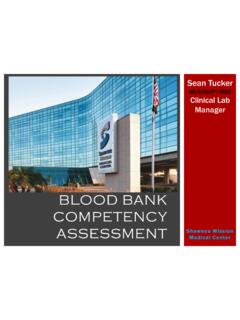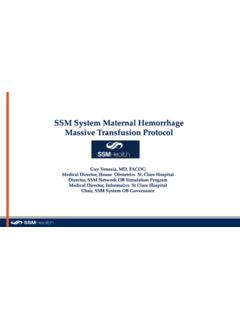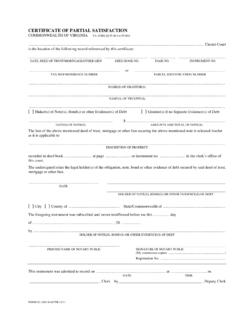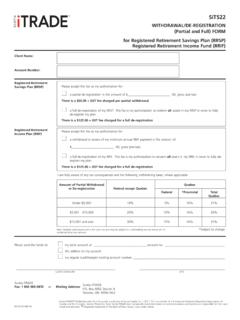Transcription of Partial D & Weak D - Heart of America Association of Blood ...
1 Partial D & Weak D Picking Up the Rhesus Pieces Susan T. Johnson, MSTM, MT(ASCP)SBB Director, Clinical Education BloodCenter of Wisconsin Heart of America Association of Blood Banks April 24, 2012 Objectives List the reasons for RhD typing discrepancies Discuss the biochemical and molecular characteristics of RhD & RHD Understand the differences among Partial , weak, Del variants and D epitopes on RhCe protein Describe the advantage of a molecular resolution of Rh discrepancies Rh DESIGNATION Rh Positive 85% Rh Negative 15% D D D D D D D D D RhD Typing Discrepancies RhD antigen expression RHD gene mutations Reagent differences Method variability CONTRIBUTORS OF VARIABILITY VARIABLES RHD Gene Weak D C in Trans to RHD Partial D Del D epitopes on RhCE Protein ceCF R0 Har or DHAR Anti-D Reagents Polyspecific Slide and Modified Tube Human IgG Monoclonal IgG Monoclonal IgM Monoclonal IgM Human IgG Monoclonal Blends Testing Platform Test Tubes IS & IAT Column Agglutination Solid Phase Liquid Microtiter Individual
2 Being Rh Typed Transfusion Recipient Obstetrical Patient Cord Blood Donor Blood Variables Impacting Rh Typing Transfusion Technology Report Vol. #013 Immucor, Inc. What is D? Rh DESIGNATION Rh Positive 85% Rh Negative 15% Rh Protein Multi-pass membrane protein Crosses RBC membrane 12 times No sugars attached 2 3 4 9 1 2 3 4 5 6 7 8 9 10 1 2 3 4 5 6 7 8 10 Locus 1 Locus 2 Exons Exons RH Genes Rh Positive RHD RHCE Locus 1 - presence of RHD codes for the presence of D or no D. Differs from RhCE by 34 to 37 amino acids (C or c) Locus 2 - presence of RHCE codes for Ce, CE, cE, ce. Chromosome 1 2 3 4 9 1 2 3 4 5 6 7 8 9 10 1 2 3 4 5 6 7 8 10 Locus 1 Locus 2 RH Genes Rh Positive RHD RHCE Chromosome 1 Rh (D) Negative Deletion of RHD in European ancestry Inactivating mutations of RHD RHD in African Americans Hybrid RHD-CE-D in African backgrounds 1 3 4 5 6 7 8 9 1 2 3 4 5 6 7 8 10 Locus 1 Locus 2 Exons RH Genes in Rh Negative Caucasians No D antigens ce antigens RHCE Locus 1 deletion of RHD therefore, no D antigen.
3 Chromosome 1 Rh (D) Negative African Background 19% RHD deletion 66% RHD 19% Hybrid RHD-CE-D 2 3 4 9 1 2 3 4 5 6 7 8 9 10 1 2 3 4 5 6 7 8 10 Locus 1 Locus 2 Exons Exons RH Genes in Rh Negative - African Background No D antigen C/c and E/e antigens RHD RHCE Locus 1 37 bp insertion & several mutations in RHD results in no product Chromosome 1 66% of AAs have RHD 2 3 4 9 1 2 3 4 5 6 7 8 9 10 1 2 3 4 5 6 7 8 10 Locus 1 Locus 2 Rh (D) Negative African Background RHD RHCE Chromosome 1 C/c and E/e antigens No D antigen Locus 1 RHCE inserted in RHD results in no D antigen and weak C. 15% of AAs have hybrid RHD-CE-D What About Weak Expression of D? WEAK EXPRESSION OF RhD HISTORY Du D mosaics Weak D general term used Partial D Weak D Specific group of RhD variants D-elution alleles WEAK D HISTORY Described by Stratton (1946) D antigen not detected by all anti-D Mistakenly called the Du antigen Du+ Blood to a D- person causes production of anti-D not anti-Du WEAK D Reactivity with Anti-D Agglutinated with some anti-D on direct agglutination (IS) Negative on direct agglutination (IS)
4 D antigen detected by IAT only Frequency of Weak Expression Hopkins Scotland 1967 Garretta France 1974 Beck USA 1990 Jenkins USA 2004 Flegel Germany 2006 WEAK D Variation in RhD Expression Do not make anti-D Able to make anti-D Weak Expression of D Do Not Make Anti-D C in trans with RHD (Ceppellini effect) r haplotype Weak D Types : single amino acid changes Weak D Type 2 Very weak(+) when in trans with r Ceppelini Effect DCe/Ce ce/ce Ce/ce DCe/ce DCe/Ce Ce/ce Ce/ce DCe/ce DCe/ce ce/ce Du Du + + + Weak D Types Do Not Make Anti-D Missense mutations in regions of RHD encoding transmembrane/cytoplasmic portion of D Less protein inserted into RBC membrane Can type as Rh-positive or Rh-negative by direct agglutination with monoclonal (IgM) anti-D reagents IS D IAT Ct.
5 IAT Anti-D 0 3 0 IS Anti-D 3+ or Some Weak D Types Type 1 Type 2 Type 3 Type Type Type 5 Type 11 Type 15 Type 19 Type 20 Account for 90% of Weak D; Do not produce Anti-D Known to form Anti-D when exposed to D+ RBCs Molecular Basis of Weak D Avent and Reid Blood (2000) 95:375 Plasma membrane Exterior Interior Type 1 Type 2 Weak D CM Westhoff IS D IAT Ct. IAT Anti-D 0 3 0 Weak D Types 1 and 2 Most common weak D types Weak D Type 1 R1r (D+C+E-c+e+) Weak D Type 2 R2r (D+C-E+c+e+) D Antigen Copy Number 2,500 2,000 1,500 1,000 500 0 type 10 type 11, 15 type 5 D antigens per Red Blood Cell G Denomme Weak Expression of D Able to Make Anti-D Partial Ds: hybrid RHD alleles DVI DIIIa DIVa, DIVb, others Del: detection by adsorption/elution D epitopes on RHCE gene RHESUS PIECES Partial D Partial D Lack exofacial epitopes Hybrid proteins Missense mutations affecting exofacial protein Plasma membrane Exterior Interior CM Westhoff Partial D IS D IAT Ct.
6 IAT Anti-D 0 3 0 IS Anti-D 3+ or 2 3 4 9 1 2 3 4 5 6 7 8 9 10 1 2 3 4 5 6 7 8 10 2 3 4 9 1 2 3 4 5 6 7 8 9 10 1 2 3 4 5 6 7 8 10 Partial DVI Normal RHD Normal RHCE One example of Partial DVI gene where 3 exons of RHCE gene are inserted into RHD gene. Partial DVI IS D IAT Ct. IAT Anti-D 0 3 0 Deletion of exon 9 in Asians occurs in 10-30% Del Type as D-negative (IS & IAT), only adsorb & elute anti-D Severely reduced protein 2 individuals have made anti-D after receiving D+ Blood D Epitope on RHCE Genes Crawford (ceCF) phenotype R0 Har, also known as DHAR 1 3 4 5 6 7 8 9 1 2 3 4 5 6 7 8 10 Locus 1 Locus 2 Exons No D antigens ce antigens RHCE DCF results from 3 nucleotide changes, 48G>C, 697C>G, 733C>G in RHce gene.
7 D Epitope on RHce Gene - DCF IS Anti-D 3+ Anti-D Reagents: Reactions with Crawford Phenotype RBCs Anti-D RBCs Reagent IgM IgG Crawford GammaClone GAMA401 F8D8 Pos Immucor-4 MS201 MS26 Neg Immucor-5 TH28 MS26 Neg Ortho Bioclone MAD2 Human polyclonal Neg Ortho (ID-MTS) MS201 Neg Reactive clones in some European reagents: RUM-1, D175-2, F5S, H2D5D2F5, MCAD-6 1 3 4 5 6 7 8 9 1 2 3 4 5 6 7 8 10 Locus 1 Locus 2 Exons No D antigens ce antigens RHCE DHAR results from one RHD exon inserted into the RHCE gene. D Epitope on RHCE Gene - DHAR IS Anti-D 3+ R0 Har Phenotype: Reactivity with Reagent Anti-D Anti-D RBCs Reagent IgM IgG R0 Har Gamma-Clone GAMA401 F8D8 Pos* Immucor-4 MS201 MS26 Pos* Immucor-5 TH28 MS26 Pos* Ortho Bioclone MAD2 Human polyclonal Neg Ortho (ID-MTS) MS201 Pos Biotest (Bio-Rad) BS232 BS221 H41 11B7 Pos Quotient - Alpha LDM1 Pos Quotient - Delta LDM1 ESD1M Pos *Positive reactions often weaker at IAT MoAb Anti-D s Method Manufacturer IgM IgG Tube Ortho MAD2 Human Tube Gamma GAMA 401 F8D8 Tube Immucor-4 MS201 MS26 Tube Immucor-5 Th28 MS26 Tube Alba(Quotient BD) alpha LDM1 Tube Alba (Quotient BD) delta LDM1 ESD1M Tube Biotest (Bio-Rad)
8 BS232 BS221 H41 11B7 Gel ID-MTS MS201 Human IgG Anti-D MONOCLONAL IgM/IgG ANTI-D MONOCLONAL IgM/IgG ANTI-D #1 Direct Agglutination - IS MONOCLONAL IgM/IgG ANTI-D #1 Weak D Test - IAT MONOCLONAL IgM/IgG ANTI-D #2 Confusion Over Weak Expression of D Donor Rh+ Recipient Rh- Prenatal RhIG? Newborn Postpartum RhIG? Autologous Donor @#!&*~? Reasons to Resolve Weak Expression Conserve Rh-negative Blood for D-negative recipients (high risk of making anti-D). Avoid giving RhIG to women who do not need it (Rh status is confirmed for historical discrepancies) Resolve early in pregnancy to eliminate false-positive rosette tests. Rh Discrepancies - MSH, Toronto 33,864 RhD phenotypings performed over an 18 month interval 55 of 5672 potential Rh-negative patients were tube test positive for one anti-D ( ) 54 were tube test negative using one FDA-approved reagent but positive (2+ or less) using another government approved antisera Discrepancy between two anti-D direct tests Summary of the Toronto Study 20 functional RHD alleles detected; 1 wildtype (HDN) 34 Weak D Types (PCR-RFLP): 16 weak D Type 1 8 weak D Type 2 1 weak D Type 3 6 weak D Type 4 1 weak D Type 5 2 weak D Type 42 7 DAR (exon mapping plus sequencing) 6 DVa or DVa-like alleles: 3 DVa(Kou.)
9 1 DVaHK(E233K) 1 DVa-like 1 DTO (Novel) DFR, DAU-4, DAU-5 (Novel), DAU-6 (Novel) DAR/DAU-2, DAU-0/Cdes (compound heterozygotes) 1 not identified (possible DIIIa, DVa, DAR, DOL) 57% were Weak D types 1, 2, 3 and 4 Impact if deemed Rh-negative RHD Allele OB TR NB Impact Weak D Types 1-4 12 8 5 12 OB patients received Rhig 4 transfusion recipients received 12 Rh-neg RBCs Weak D Type 42 1 1 - OB patient received Rhig Transfusion recipient received 11 Rh-neg RBCs Total: 21 RhIG 23 Rh-negative RBCs DAR 3 1 3 3 OB patients received Rhig Potential transfusion recipient was not transfused. DVa and DVa-like 1 1 5 1 OB patient an delivered an Rh-neg infant Potential transfusion recipient not transfused DAU, DFR, DTO 3 2 2 2 OB patient delivered an Rh+ infant Neither potential transfusion recipient transfused Total.
10 7 Rhig 0 Rh-negative RBCs Inappropriate use of Blood products Summary of Alberta Study DNA Typing Results # of Patients Rh Status Assigned RHIG Recommended % of DNA Results Received Weak D Type 1 60 Pos No Weak D Type 2 19 Pos No Weak D Type 3 38 Pos No Weak D Type 4 15 Pos No DAR 2 Neg Yes Partial DVI Type I 3 Neg Yes Partial DVI Type II 1 Neg Yes DVI Type II 2 Neg Yes DVa Partial 1 Neg Yes Partial DVA-like 1 Neg Yes Unclassified 65 Neg Yes Pending 2 TBD TBD TOTAL 209 ( of total) Analysis 07 08 = 88,972 64% 36% Monoclonal Anti-D Panel Interpretation: DVI Both >2+ score Anti-D (std method) Negative No Inconclusive Rh Negative Rh Positive Yes No At least one <2+ score Report Rh(+) Tube Test - key anti-Ds Report Rh Indeterminate No Anti-D (method 1) >2+ agglutination score No Yes Yes Matches historical?











